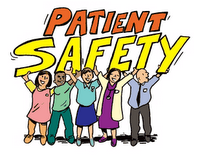Improving Patient Safety - A Systems Approach
Objectives for this course are:
|
Terms used in Patient Safety:
|
| “Treasure Hunt” for Patient Safety
Using Web Resources links below and the Treasure Hunt form (if you haven't already printed the form here is is again: click here), then... go on an internet exploration to answer the following questions: 1. Name at least 2 of the Institute of Medicine’s (IOM) 6 Aims for Improvement
2. List 2 reasons why a systematic, consistent strategy such as a surgical checklist can improve safety and quality of care
3. Name 4 web resources with information for improving patient care.
8. Please provide feedback to WikiEducator page creator with suggestions for improvement of this course. What worked well? What needs improvement? What did you find difficult about using this page or format? We need your feedback!
|
General Information on Patient Safety and Quality
- Institute for Healthcare Improvement (IHI) Open School video Defining Quality (4 minutes, 36 seconds): [2]
- IHI webpage Across the Chasm: Six Aims for Changing the Health Care System: [3]
- IHI Open School video Why do Errors Happen, and How Can We Prevent Them (4 minutes, 42 seconds):[4]
- Why Report Errors? A news report re: an Australian hospital's increased safety with increased error reporting (1 minute 38 seconds): [5]
- Addressing Medical Error: Promoting Patient Safety video featuring Brian Liang MD, JD (anesthesiologist, pilot, lawyer) (47 minutes, 22 seconds): [6]
- Slideshow from SlideShare Reducing Medical Error and Increasing Patient Safety, by Richard Smith, editor of the British Medical Journal: (29 slides): [7]
- Agency on Healthcare Research and Quality (AHRQ) 2008 Quality and Disparities reports show that the annual rate of improvement in health care quality is very low, and patient safety is actually getting worse rather than better (audio - 3 minutes, 28 seconds) : [8]
- IHI Open School video The Future (Challenges in Healthcare) national healthcare leaders discussing current issues, and where do we go from here (7 minutes, 8 seconds): [9]
- World Health Organization (WHO) website Safe Surgery Saves Lives, with information on implementing surgical checklists: [10]
- A great resource book about systems and quality: Quality by Design: A clinical microsystem approach edited by Eugene C. Nelson, Paul B Batalden, Marjorie M. Godrey (pages 5 and 13 are of particular interest for this class, on systems). Explore the book here: [11]
Frontline Staff Perspective:
- IHI Open School video Change Driven From the Bottom Up (1 hour, 12 minutes): [12]
- IHI Open School slideshow Change Driven From the Bottom Up a quick summary of above video: slideshow
- IHI website on providing feedback to front-line staff [13]
Patient Perspective:
- "Hurt By Medicine: Patients Talk" audio from Harvard affiliate CRICO/RMF: [14]
- For the patient/consumer perspective, visit Consumers Union Safe Patient Project website: [15] and watch the videos with patient stories (5 videos 2-3 minutes each): [16]
International Perspective:
- A flyer for the Canadian Safety Competencies Framework, in a one page format: [17]
- Information on patient safety from the European Union public health website:[18]
- WHO patient safety website: [19]
- Junior doctors make mistakes in 8% of hospital prescriptions, study finds: [20]
For further information on the topic of Patient Safety, here are some more articles and videos you might be interested in:
- National Patient Safety Foundation video (long, but very good overview) "To Err is Human" Report Retrospective and the Decade Ahead [21]
- IHI White Paper - Engaging Physicians': [22]
- Agency for Healthcare Research and Quality (AHRQ) Patient Safety Tools: [23]
- Joint Commission website on patient safety: [24]
- Here is the entire document, in PDF format for the Canadian Safety Competencies Framework:[25]
| Please evaluate this course
Click here for printable form, and submit with your Treasure Hunt form for course credit
|
For References: click here
http://3.bp.blogspot.com/_jcFDWu1jEPk/SIi6bi8WqCI/AAAAAAAAAG0/yrWdopKEYUo/s200/0926162957_patient_safety.gif
"Patient Safety" image found on Google Images accessed 11/17/09 from:http://www.wellsphere.com/healthcare-industry-policy-article/joint-commission-2009-national-patient-safety-standards-reality-compared-with-expectations/540411

